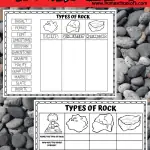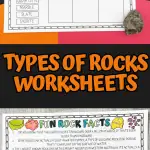Free Types of Rocks Worksheet for Kids
Are you learning about rocks with your students? If so you are going to love this free types of rocks worksheet.
We’ve got three free printable science worksheets lined up that will help your students understand all about different types of rocks, how they’re formed, and how we classify them.
These rock worksheets will be a great addition to your earth science lessons. They are no prep download, so perfect for last-minute planning!
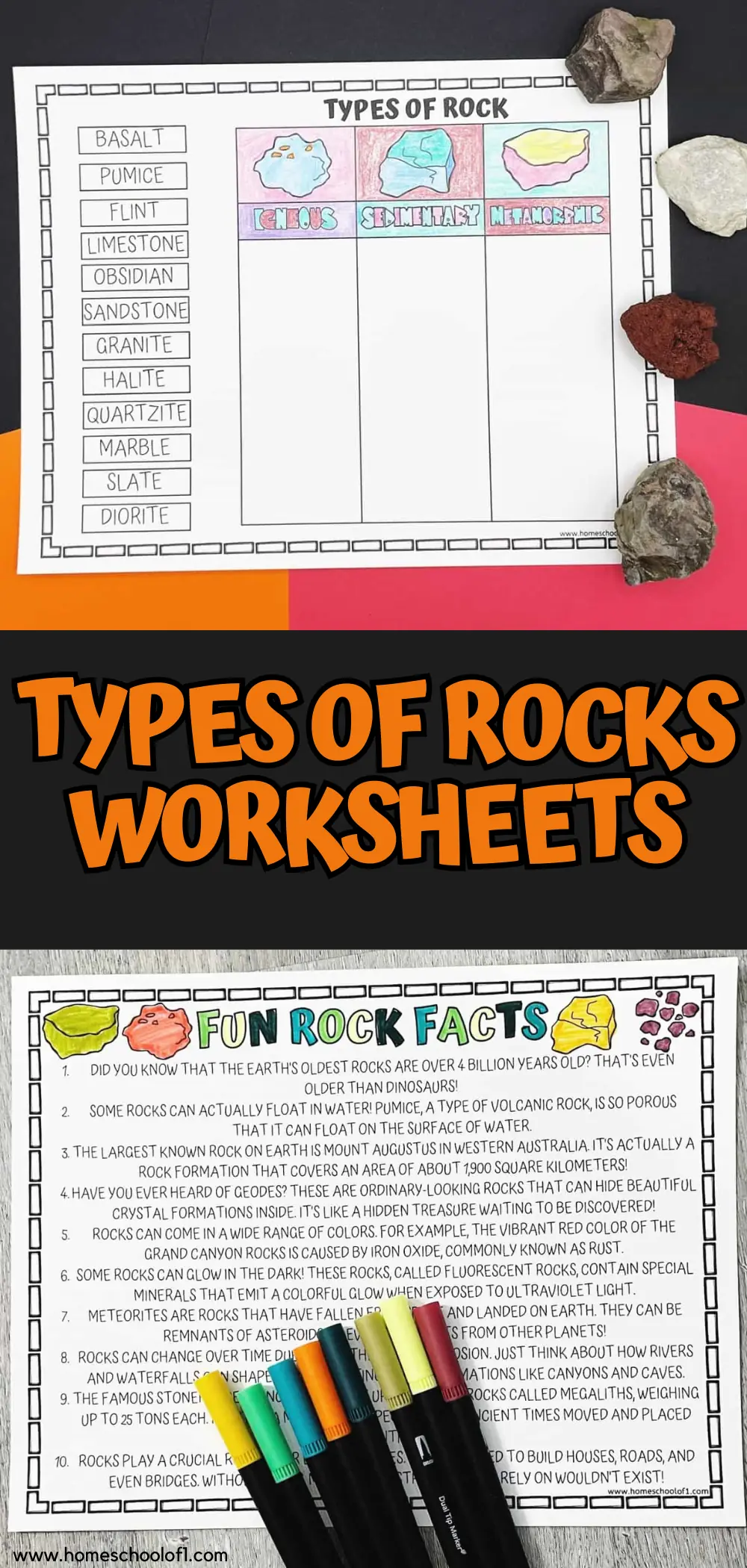
**This post may contain affiliate links. As an Amazon Associate and a participant in other affiliate programs, I earn a commission on qualifying purchases.**
The kids will have a blast identifying rocks based on their unique features and sorting them into specific groups.
These worksheets are not only interactive and fun but also super educational. Plus the answer sheet is included.
Fun facts about rocks for kids
Learning about rocks can be fun, so make sure you share some of these fun facts with your students:
- Did you know that the Earth’s oldest rocks are over 4 billion years old? That’s even older than dinosaurs!
- Some rocks can actually float in water! Pumice, a type of volcanic rock, is so porous that it can float on the surface of water.
- The largest known rock on Earth is Mount Augustus in Western Australia. It’s actually a rock formation that covers an area of about 1,900 square kilometers!
- Have you ever heard of geodes? These are ordinary-looking rocks that can hide beautiful crystal formations inside. It’s like a hidden treasure waiting to be discovered!
- Rocks can come in a wide range of colors. For example, the vibrant red color of the Grand Canyon rocks is caused by iron oxide, commonly known as rust.
- Some rocks can glow in the dark! These rocks, called fluorescent rocks, contain special minerals that emit a colorful glow when exposed to ultraviolet light.
- Meteorites are rocks that have fallen from space and landed on Earth. They can be remnants of asteroids or even fragments from other planets!
- Rocks can change over time due to weathering and erosion. Just think about how rivers and waterfalls can shape rocks, creating unique formations like canyons and caves.
- The famous Stonehenge in England is made up of massive rocks called megaliths, weighing up to 25 tons each. It’s still a mystery how people from ancient times moved and placed these gigantic stones!
- Rocks play a crucial role in our everyday lives. They are used to build houses, roads, and even bridges. Without rocks, many of the structures we rely on wouldn’t exist!
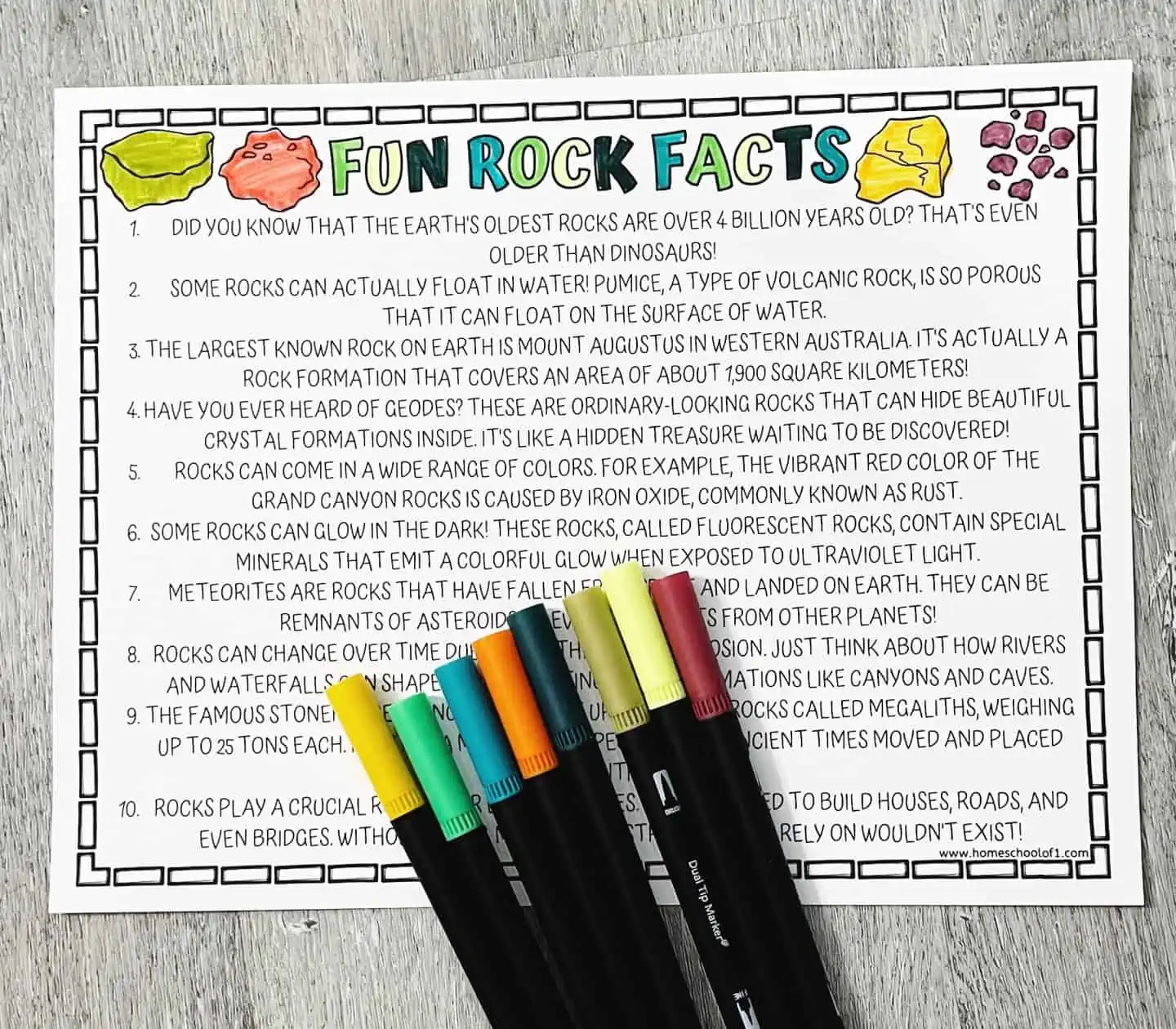
Different types of rocks
Our first worksheet is designed to challenge young geologists with four intriguing questions.
Guided by illustrations, children will be tasked with identifying the type of rock, understanding how rocks are formed, discovering their natural habitats, and even exploring examples of rocks found in our world.
Through these thought-provoking questions, children will be encouraged to observe, think critically, and expand their understanding of the fascinating origins and diversity of rocks.
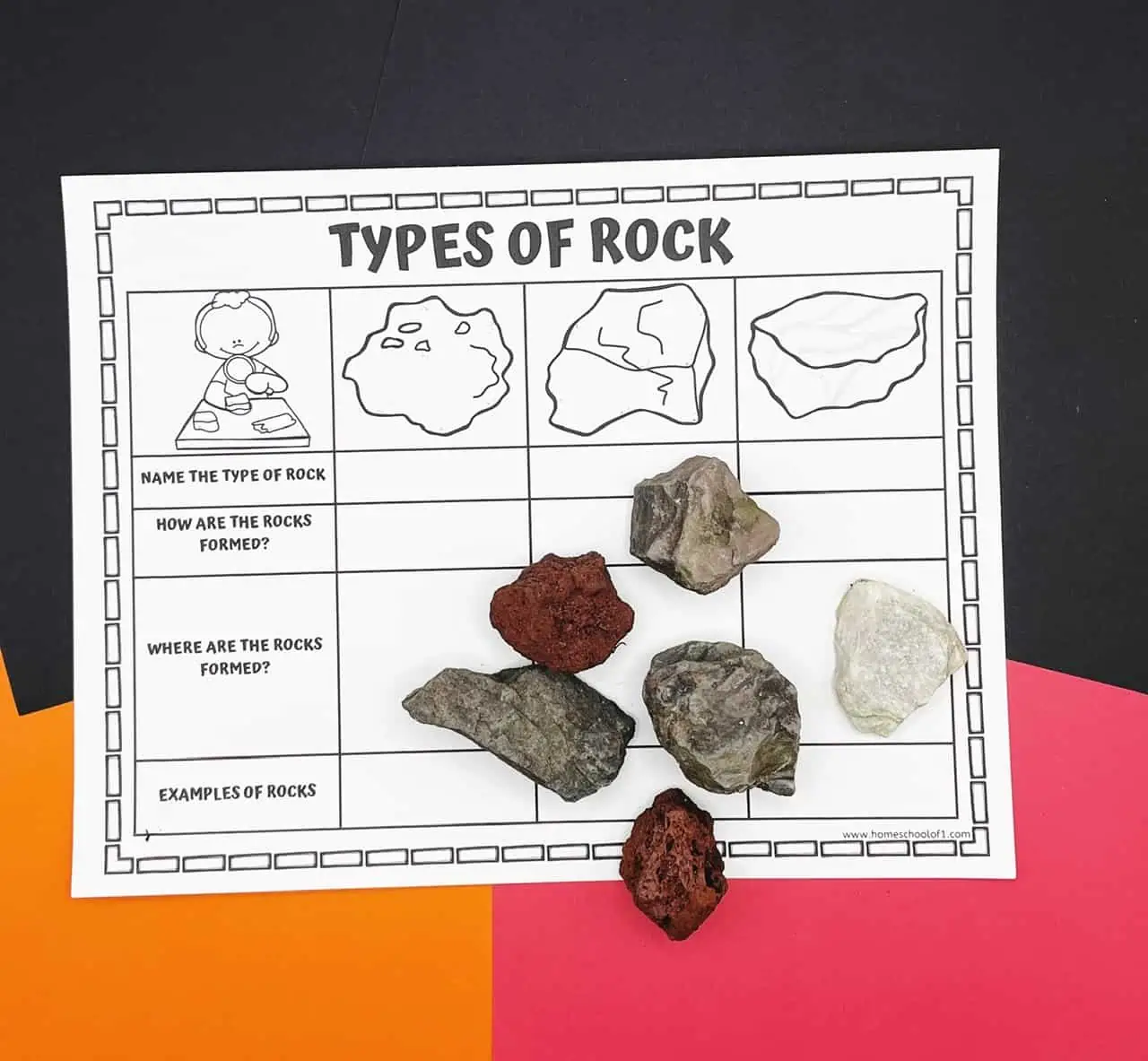
There is also the exact same worksheet but with a picture of a girl. Plus the answer sheet is included.
Igneous-rock
How are the rocks formed: Igneous rock forms when molten rock (magma or lava) cools and solidifies. Magma cools underground to form intrusive igneous rocks, while lava cools on the Earth’s surface to form extrusive igneous rocks. Cooling rate affects the rock’s texture.
Where are the rocks formed: Igneous rocks form in two main locations:
- Intrusive Igneous Rocks: These form beneath the Earth’s surface from the slow cooling of magma, resulting in coarse-grained textures. Common sites are within continental crust or under oceanic islands.
- Extrusive Igneous Rocks: These form on or near the Earth’s surface when lava cools rapidly, often resulting in fine-grained textures. This happens typically at or near volcanic regions, like along mid-ocean ridges, volcanic islands, or continental volcanoes.
Sedimentary rock
How are the rocks formed: Sedimentary rock forms through the deposition, compaction, and cementation of sediment. This sediment is derived from the weathering and erosion of pre-existing rocks, transported by water, wind, or ice, and deposited in layers over time.
Where are the rocks formed: They begin with the weathering of the exposed rock into small fragments. Through erosion, these fragments are removed from their source and transported by wind, water, or ice, to a new location. Once it settles the lowest layers become compacted so tightly that they form solid rock.
Have fun with our rock cycle coloring sheet too!
Metamorphic rock
How are the rocks formed: Metamorphic rock forms when existing rock is subjected to high temperatures, pressures, or chemically active fluids, altering its mineral structure without melting. This process, called metamorphism, occurs deep underground or in tectonic zones.
Where are the rocks formed: Metamorphic rocks form deep underground and at tectonic boundaries. These environments expose rocks to intense pressure and heat, transforming them through processes like recrystallization during mountain building or where tectonic plates collide.
Add these worksheets to a fun geology unit study.
Younger kids will love our preschool rock activities!
Sorting rocks worksheet
This engaging worksheet guides young geologists on a journey to categorize various rock samples into three distinct groups: igneous, sedimentary, or metamorphic rocks.
Igneous Rocks: Include rock samples like pumice, basalt, obsidian, granite, and diorite. These rocks form from the cooling of magma or lava.
Sedimentary Rocks: Include samples like sandstone, limestone, flint, and halite. These are formed by the accumulation and cementation of sediments.
Metamorphic Rocks: Include samples like quartzite, marble, and slate, which are formed under high pressure and temperature conditions that alter their original structure.
Activity objective:
Children will interact with these rock samples to observe and analyze their unique features and characteristics.
This hands-on experience will help them develop a keen eye for detail and enhance their ability to classify rocks based on their formation processes and geological changes.
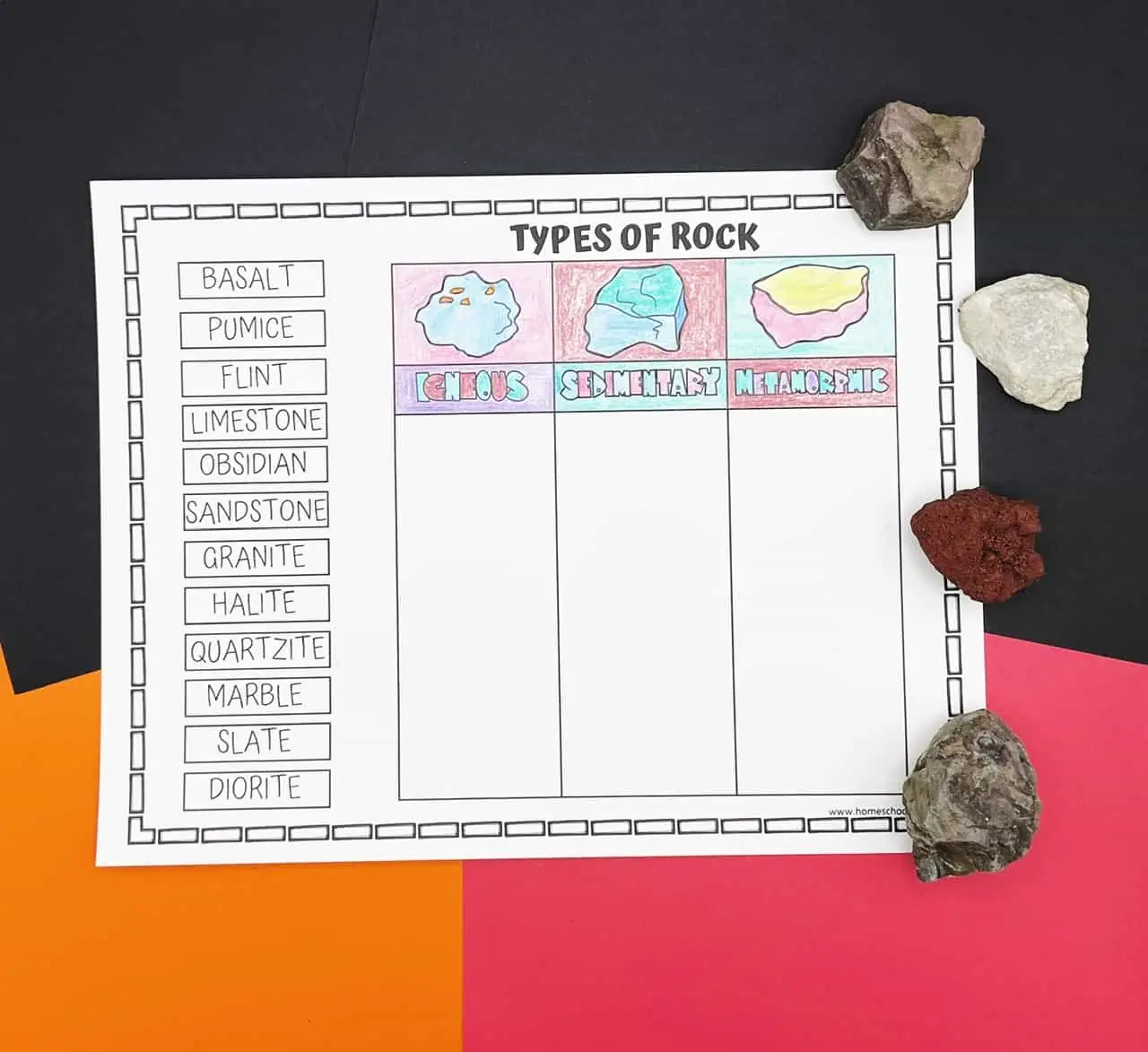
Educational benefits:
- Enhanced observational skills: Handling real rock samples allows children to notice subtle differences and similarities between the rocks.
- Deepened geological understanding: By sorting these rocks, children will learn more about the geological processes that shape our planet, such as cooling, sedimentation, and metamorphism.
This worksheet is a practical tool for budding geologists to connect theoretical knowledge with real-world applications, making learning both fun and immersive.
Continue learning with our free rock cycle worksheets.
Best books about rocks for kids
Add some interesting books to your study, these are some of our favorite rock books:
My Book of Rocks and Minerals is an interactive guide that takes young rock enthusiasts on a journey to discover and appreciate the wonders of rocks and minerals. Packed with stunning photographs, informative descriptions, and engaging activities. This book encourages children to explore, collect, and treasure various specimens while learning about their unique properties.
Ultimate Rockopedia is a comprehensive and visually stunning reference book that covers a wide range of rocks and minerals from around the world. With detailed information on identification, formation, and characteristics, as well as captivating images and fun facts. This ultimate guide is perfect for rock enthusiasts of all ages. Providing an extensive resource for anyone interested in the fascinating world of geology.
100 Questions About Rocks & Minerals is a captivating book that answers a multitude of intriguing questions about rocks and minerals. Packed with sparkling statistics and fascinating facts. This book offers curious minds an entertaining and informative exploration of the Earth’s geological wonders. Making it a perfect companion for anyone seeking to deepen their understanding of rocks and minerals.
Need to print later? Add this to your Pinterest board or share it on Facebook. You’ll have it handy whenever you’re ready to use it!
Download the free rock types worksheets
Ready to grab your free printable? Just pop your name and email into the form below, and it’s all yours!
Last Updated on 9 January 2025 by Clare Brown

